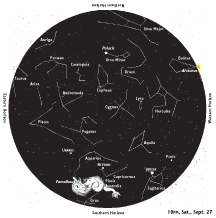 |
|
Sky Watch by J. Alex Knoll Autumn’s Celestial FishBrilliant Fomalhaut shines like a sentinel in the south
The sun sets before 7pm this week, disappearing more than a minute earlier night by night. So close still to equinox, the sun sets just off of due west, but it creeps southward each night, until roughly a month from now, on Halloween, the sun will set almost an hour earlier and more than 15 degrees lower at west-southwest. Nightfall reveals the Autumn Star, Fomalhaut, rising in the southeast, while the Spring Star, Arcturus, burns low in the northwest. This week around 9pm, the two are juxtaposed, each about 10 degrees above the skyline. A first magnitude star, Fomalhaut the mouth of the southern fish Piscis Austrinus, is the brightest star in the dim sea of autumn’s water constellations and is the 17th brightest overall. At just 25 light years away, it is also one of the closest. Fomalhaut is some 15 times more luminous than our sun, but astronomers have discovered a massive cloud four times the size of our solar system surrounding the star. An accumulation of such celestial ice and dust likely led to our own solar system’s creation. Five thousand years ago in Persia’s cradle of civilization, Fomalhaut was one of the four royal stars, protecting the southern heavens, while Regulus, Aldebaran and Antares stood guard over the other cardinal compass points. This month, Fomalhaut shines through of the night, setting in the southwest around 3am. Early risers Friday morning can see bright Regulus just a couple degrees above the upper tip of the thin, waning crescent moon. Around 6am Saturday, the moon appears low in the east with golden Saturn just five degrees beneath the moon’s lower tip. Illustration: © Copyright 1925 M.C. Escher/Cordon Art-Baarn-Holland; Graphics: © Copyright 2007 Pacific Publishers. Reprinted by permission from the Tidelog graphic almanac. Bound copies of the annual Tidelog for Chesapeake Bay are $14.95 ppd. from Pacific Publishers, Box 480, Bolinas, CA 94924. Phone 415-868-2909. Weather affects tides. This information is believed to be reliable but no guarantee of accuracy is made by Bay Weekly or Pacific Publishers. The actual layout of Tidelog differs from that used in Bay Weekly. Tidelog graphics are repositioned to reflect Bay Weekly’s distribution cycle.Tides are based on National Oceanic and Atmospheric Administration and are positioned to coincide with high and low tides of Tidelog. |
|
|
|
|
|
© COPYRIGHT 2008 by New Bay Enterprises, Inc. All rights reserved. |


